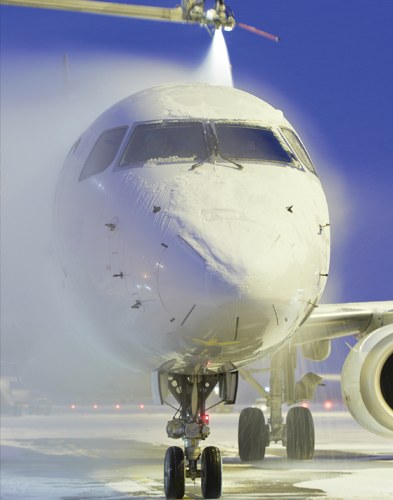On a cold and windy day 115 years ago this December, Orville and Wilbur Wright made the first successful flight of a self‑propelled, heavier‑than‑air aircraft. That momentous day in Kitty Hawk, North Carolina, spawned an industry that is now worth hundreds of billions of dollars a year. It has changed the way we not only travel but also how think about the world.

From that first landing on sand after a 12‑ second flight, aviation has become one of the world’s biggest and most important industries, with associated sectors from safety, refuelling, inflight entertainment and refreshments, to air traffic control and baggage handling. The link between aviation and pollution liability was late being made, with environmental impairment liability insurance not being introduced until the late 1970s. But there are many factors that those involved in aviation‑associated sectors must bear in mind today.
Environmental risk exposures for companies (and their risk managers) continue to increase due to changes in legislation and an increase in social awareness and public pressure. In addition, there is anecdotal evidence of an increase in consistency in enforcement in many markets of new environmental regulation. Overall, we see two main pillars that drive the discussion of environmental risk and increase the value of specialized environmental insurance programs.
1. Increase in frequency of claims – as new regulations emerge and take hold, coupled with public awareness and consistency in enforcement, we see a future of increased claims activity. Although one could question the pace of this increase, it would be hard to argue that there would be an actual global decrease in claims activities for companies that fail to manage their environmental exposures properly.
2. Increase in claims complexity/cost ‑ our experience illustrates that as time goes forward, claim complexity increases. This is primarily as a result of the implementation of new regulations, globally, and the increased number of stakeholders involved when a pollution incident or environmental damage event takes place. So overall with a trend in increasing claims frequency coupled with an increase in claims complexity, we can see that the demand for education around environmental exposures and available environmental insurance coverage will continue on its growth path.
Pollution from aviation sector and pollution from ‘fixed base operations’
When looking at the aviation sector, we need to question what are the prevailing environmental exposures? Are airport owners and operators exposed to environmental risks? Is there insurance protection in general liability policies? Pollution can be introduced into the environment from many sources in the aviation sector. For instance, those introduced over a widespread area such as aircraft emissions and vehicle traffic in and around an airport. There are also those resulting from more specific activities at an airport (a ‘Fixed‑ Based Operator’), for example:
. Fueling operations
. Fuel storage and hydrant systems
. Operation of aircraft
. Aircraft and ground service equipment maintenance
. Firefighting training areas
. De‑icing activities
. Terminal operations including waste management
These can all be exacerbated by construction and expansion activities including the acquisition of additional land.
Costs arising out of pollution events can include:
. Third‑ party bodily injury claims
. Third‑ party property damage
. Investigation, clean‑ up and remediation costs
. Oversight and monitoring costs
. Legal defense costs
. Loss of use and business interruption expense costs
. Natural resources and environmental damage claims
Real examples tell the story of risk
Construction work
In the case of a contractor working at an airfield, 36,000 gallons of fuel leaked into the ground rather than being delivered to aircraft. An investigation found part of a drilling machine stuck into the fuel pipe. Even after mitigation measures, the pipe still continued to leak. The incident raised questions around underground hazards, and the role of site owners and contractors.
Fuel Distribution
A London based company which supplied and distributed fuel at an airport severely polluted groundwater with at least 139,000 litres of fuel, at a rate of seven litres a second. The leak was inadvertently discovered during an investigation into an unrelated incident. The fuel is likely to be recovered at 80 litres a week, or slower, at a cost of around £1m.
De‑icing
An airport executive was fined for polluting a river by irregular release of de‑icing compounds from activities on a runway. Contamination of 85 times the acceptable level were found after a control process to avoid spills broke down. The airport was warned after a previous event approximately a year earlier and the incident was noticed due to monitoring controls.
Fire fighting
A Port Authority recently detected contaminated soil and groundwater at one of their Airports, which has been traced back over 50 years. They entered into a voluntary clean‑up agreement primarily focused on chemical compounds PFOS (perfluorooctane sulfonate) and PFOA (perfluorooctanoic acid). An investigation into the extent of the contamination is ongoing. PFOS and PFOA have been classified as a potential threat to health, wildlife and the environment. There is concern that these could contaminate drinking water. The chemicals do not readily breakdown, so airports should be prudent about their existence, even if their use has been phased out many years ago. It is likely the contamination stems from fire training as far back as the 1960s, when foams that contain PFOS and PFOA had been used to extinguish fires.
Ground transportation
Late last year, a ground transportation company at a major UK airport was fined when staff poured waste material directly into a river, rather than taking it to a regulated disposal site. While it may seem quite difficult to trace the cause of pollution, environmental regulators have the technology and skills to identify the sources of contamination.
General liability and aviation insurance markets
Environmental coverage in "traditional” property and casualty policies is certainly inconsistent across global markets. Additionally, the coverage is typically not comprehensive with regards to relevant environmental exposures. In some cases, there is no pollution coverage except if caused by hostile fire, and often then just limited only to third‑party bodily injury and third‑ party property damage – not including any first party clean‑up coverage. Some extensions provide coverage for named perils such as fire, windstorm, lightning, explosion, or collision, but are still limited only to third‑party bodily injury and third‑party property damage.
Broader forms can grant some type of sudden and accidental (‘S&A’) coverage with strict requirements for discovery and reporting periods, but again often limited only to third‑ party bodily injury and third‑party property damage. More specifically in the aviation insurance market, one can often see the application of a restrictive AVN 46B (Noise and Pollution and Other Perils Exclusion Clause) wording. This states that the policy does not apply to claims directly or indirectly occasioned by, happening through or in consequence of pollution and contamination of any kind whatsoever unless caused by or resulting in a crash fire explosion or collision or a recorded in‑flight emergency causing abnormal aircraft operation.
Regardless of coverage in a "traditional” property and casualty policy, there are still significant exclusions and exceptions such as gradual releases, first party coverage, regulatory liability, waste disposal or natural resource and biodiversity damage. In some cases there may be coverage "buy backs” for some elements of statutory environmental liability and even natural resource and environmental damage claims, but usually with low sub‑ limits and irrespective of the operation’s true exposure.
Specialist environmental markets
The specialist environmental market’s products on the other hand are designed around a broad range of environmental liabilities and impairment risk. Specialist environmental underwriters, often with environmental consulting and engineering backgrounds, have the expertise to understand and provide coverages for some of the more complex elements. Coverage can include:
. Gradual and S&A pollution
. Clean‑up costs
. Natural resources/biodiversity damage
. Business interruption expense
. Third‑ party bodily injury and property damage
. Legal costs
. Transportation
. Non‑owned waste disposal site liability
. Underground storage tank liability
. Pre‑existing conditions
Policies can be tailored to the owner and/ or the fixed based operator’s liability but also to contractors’ coverage for liability arising due to claims resulting from exacerbation of existing pollution or other release caused by construction, development or remediation activities.
There are a number of actions that can be taken including ensuring that pollution and environmental risk are evaluated properly, including historical contamination at the site.
It is also important to review if the risk management practices used to manage environmental risk are adequate. Risk transfer and indemnification language in vendor FBO (Federal Business Opportunity) contracts should also be reviewed for adequacy and consideration should be given to mandating insurance requirements for vendors and contractors. It is also recommended that there is a review on the reliance on airport sovereign and governmental immunity.
It is always good practice to review current insurance coverage for gaps and consider the availability of specialist environmental insurance.
By Stephen Andrews, Aspen Insurance



